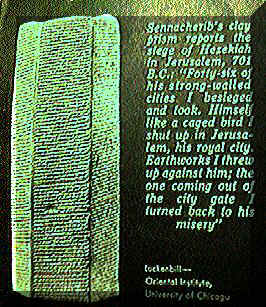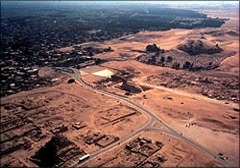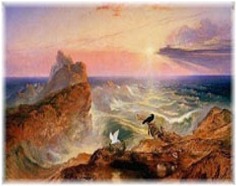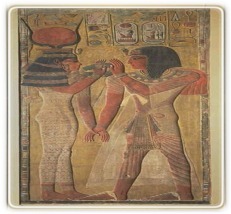| Site
Overview Home
Contact
Egyptology
Daniel
Orion
Archeology
Groliers
The Papacy
The Flood
Revolution
Lincoln
Left Behind
Part
1
Part2
Part3
Part4
Footnotes
Holy War
Jehod
Watchman
Yahoo Debate
What's New-
2001:
The
True Church
The
Dwelling-
Place of God
Babylon
Kingdoms
The Mother of-
God
Ghosts
The Beast of-
Revelation 13
Making-
Preparation
A Bible
Love
Woman's Rights
2002:
The way of God
Three Angels
Yom Kippur
2003:
Abomination
of Desolation
2004:
The Last
World Empire
|
|
Goliers
Nineveh
{nin'-uh-vuh}
 Nineveh, the capital of
ancient ASSYRIA, lies on the left bank of the Tigris River opposite
present-day Mosul, Iraq. Prehistoric occupation of the site dates back to at
least the 6th millennium BC. Holding an important position on the main river
crossing in the fertile northern Mesopotamian plain but only intermittently
governed by local rulers, Nineveh was dominated in the 3d millennium BC by
the Agade and Ur empires and in the 2d millennium by the Mitanni and Kassite
empires. With the rise of Assyrian power in the late 2d millennium, the city
became a royal residence and was finally established as the capital by King SENNACHERIB
(r. 704-681 BC), who replanned the city and built for himself a magnificent
palace. Sacked (612 BC) by the Medes, Nineveh declined,
although occupation of the site continued through the Seleucid and Parthian
periods until medieval times.
Sennacherib's city wall, more than 12 km (7.5 mi) long, enclosed an area of
about 700 ha (1730 acres); it was pierced by 15 great gates, five of which
have been excavated. The northern Nergal Gate, with its original flanking
bull colossuses, has been restored. Canals provided water to the city and to
municipal gardens that were stocked with unusual plants and animals.
Sections of an aqueduct built by Sennacherib still stand at Jerwan, 40 km
(25 mi) away. The palaces of Sennacherib and his grandson ASHURBANIPAL stand
at Kuyunjik, the citadel of the site. Nineveh, the capital of
ancient ASSYRIA, lies on the left bank of the Tigris River opposite
present-day Mosul, Iraq. Prehistoric occupation of the site dates back to at
least the 6th millennium BC. Holding an important position on the main river
crossing in the fertile northern Mesopotamian plain but only intermittently
governed by local rulers, Nineveh was dominated in the 3d millennium BC by
the Agade and Ur empires and in the 2d millennium by the Mitanni and Kassite
empires. With the rise of Assyrian power in the late 2d millennium, the city
became a royal residence and was finally established as the capital by King SENNACHERIB
(r. 704-681 BC), who replanned the city and built for himself a magnificent
palace. Sacked (612 BC) by the Medes, Nineveh declined,
although occupation of the site continued through the Seleucid and Parthian
periods until medieval times.
Sennacherib's city wall, more than 12 km (7.5 mi) long, enclosed an area of
about 700 ha (1730 acres); it was pierced by 15 great gates, five of which
have been excavated. The northern Nergal Gate, with its original flanking
bull colossuses, has been restored. Canals provided water to the city and to
municipal gardens that were stocked with unusual plants and animals.
Sections of an aqueduct built by Sennacherib still stand at Jerwan, 40 km
(25 mi) away. The palaces of Sennacherib and his grandson ASHURBANIPAL stand
at Kuyunjik, the citadel of the site.
Their walls and
doorways were lined with sculptured reliefs, many of which are now in the
Louvre, Paris, and the British Museum, London (including Ashurbanipal's
famous Lion Hunt reliefs, now in the British Museum). Sennacherib's palace
comprised at least 80 rooms; the throne room suite, now partially restored,
still contains some of its bas-reliefs depicting scenes of conquest.
Archives of cuneiform tablets were found in both palaces, but the library of
Ashurbanipal forms an unrivaled epigraphic source for current knowledge of
Mesopotamian history. One of the greatest treasures
of ancient Mesopotamia,the
Babylonian Flood story;
The E-mashmash
temple, dedicated to the goddess Ishtar, also stood on Kuyunjik; its series
of superimposed structures, dating back to the 3d millennium BC, were
maintained by successive rulers of Assyria and survived until at least AD
200. The imperial arsenal, built by Sennacherib's successor Esarhaddon (r.
680-669 BC), stands largely unexcavated at Nebi Yunus, a mound on the city
wall 1.6 km (1 mi) south of Kuyunjik. It is still covered by modern
buildings, among them a mosque reputed to contain the tomb of Jonah.
Nineveh
was first surveyed in 1820; intermittent excavation by various expeditions
took place from 1842 to 1931; more recent work, including some restoration,
has been undertaken by the Iraq Department of Antiquities.
Kate
Fielden
Bibliography:
Goodspeed, George S., A History of the Babylonians and the Assyrians
(1978); Hancock, Percy S.
P., Mesopotamian Archaeology (1912;
repr. 1977);
Olstead, Albert T., History of Assyria (1923;
repr. 1975);
Thompson, R. Campbell, and Hutchinson, Richard W., A Century of
Exploration at Nineveh (1929)
Egyptology
l
Orion
l
Archeology
l
The Papasy
l
The Flood
l
Left Behind
l
Holy War
l
Watchman
l
Yahoo Debate
l
Whats New
|
|
Why
Mosescats.com?
Why
Study Prophecy

__________________ 
Back to
Archaeology



Amos 5:8
Seek him that
maketh the seven stars and Orion, and turneth the shadow of death into the
morning, and maketh the day dark with night: that calleth for the waters
of the sea, and poureth them out upon the face of the earth: The LORD is
his name:

Connections

Site
Content by:
 Site
Construction by:


THIS
SITE IS DEDICATED TO THE BIBLICAL
RECORD AND ITS SCIENTIFIC IMPLICATIONS
|
 Nineveh, the capital of
ancient ASSYRIA, lies on the left bank of the Tigris River opposite
present-day Mosul, Iraq. Prehistoric occupation of the site dates back to at
least the 6th millennium BC. Holding an important position on the main river
crossing in the fertile northern Mesopotamian plain but only intermittently
governed by local rulers, Nineveh was dominated in the 3d millennium BC by
the Agade and Ur empires and in the 2d millennium by the Mitanni and Kassite
empires. With the rise of Assyrian power in the late 2d millennium, the city
became a royal residence and was finally established as the capital by King SENNACHERIB
(r. 704-681 BC), who replanned the city and built for himself a magnificent
palace. Sacked (612 BC) by the Medes, Nineveh declined,
although occupation of the site continued through the Seleucid and Parthian
periods until medieval times.
Nineveh, the capital of
ancient ASSYRIA, lies on the left bank of the Tigris River opposite
present-day Mosul, Iraq. Prehistoric occupation of the site dates back to at
least the 6th millennium BC. Holding an important position on the main river
crossing in the fertile northern Mesopotamian plain but only intermittently
governed by local rulers, Nineveh was dominated in the 3d millennium BC by
the Agade and Ur empires and in the 2d millennium by the Mitanni and Kassite
empires. With the rise of Assyrian power in the late 2d millennium, the city
became a royal residence and was finally established as the capital by King SENNACHERIB
(r. 704-681 BC), who replanned the city and built for himself a magnificent
palace. Sacked (612 BC) by the Medes, Nineveh declined,
although occupation of the site continued through the Seleucid and Parthian
periods until medieval times.





